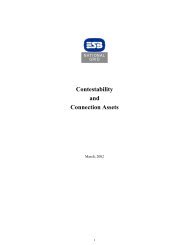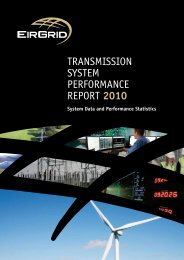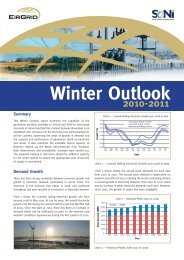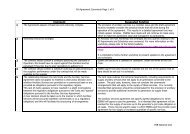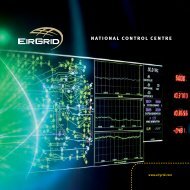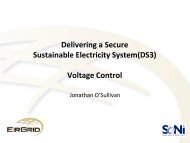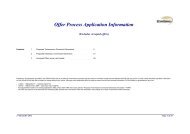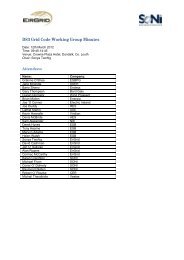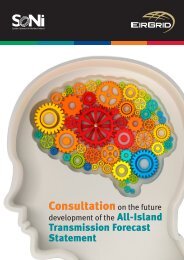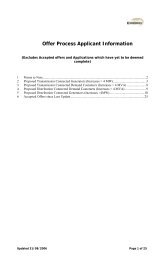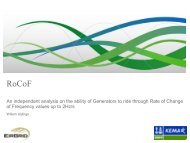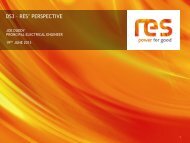DS3 Programme Advisory Council Meeting Minutes ... - Eirgrid
DS3 Programme Advisory Council Meeting Minutes ... - Eirgrid
DS3 Programme Advisory Council Meeting Minutes ... - Eirgrid
Create successful ePaper yourself
Turn your PDF publications into a flip-book with our unique Google optimized e-Paper software.
<strong>DS3</strong> <strong>Programme</strong> <strong>Advisory</strong> <strong>Council</strong> <strong>Meeting</strong> <strong>Minutes</strong><br />
Date: 19/03/2013<br />
Time: 10.15 – 13.45<br />
Venue: Radisson Blu Hotel, Belfast.<br />
Chair:<br />
Attendees:<br />
Apologies:<br />
Andrew Cooke<br />
Michael Preston, Michael Conlon, Tony Hearne, Stephen Walsh, Mark O’Malley,<br />
Colm O’Conaill, Conor Kavanagh, Donal Smith, Grainne O’Shea, Paul Brady, Joe<br />
Duddy, Peter Duffy, Gerry Hodgkinson, Peter Harte, Ian Luney, Martin McCarthy,<br />
Brian Carroll, Catriona Diviney, Paul Brandon, Peter Thomas, Tom McCartan, Ivan<br />
Duduyrch, Andrew Cooke, Yvonne Coughlan, Jon O’Sullivan, Peter Baillie, Mark<br />
Gormley, Simon Tweed, Eadaoin McLoughlin<br />
Andrew McCorriston, Pamela Walsh, Carsten Junge, Colin Spain, Mervyn Adams,<br />
Paul Hickey<br />
Review of Actions from last meeting<br />
The actions from the last meeting were reviewed.<br />
It was clarified that the reviews on Biomass and Storage Technologies were not circulated to <strong>Advisory</strong><br />
<strong>Council</strong> members as these reviews were conducted as an exercise by a student on placement with<br />
EirGrid during the summer and do not necessarily reflect the TSOs’ views on the topics.<br />
There was a discussion about organizing a meeting to develop a template for the curtailment reports.<br />
IWEA expressed concern that this may slow down the process as they had already done a large<br />
amount of work in this area. It was decided to take the comments to date from IWEA as a starting<br />
point in the development of this template. There will be representatives from all priority dispatch<br />
renewable producers at this meeting.<br />
Action Item:<br />
1. TSOs to organize meeting to discuss curtailment report template by second week in April.<br />
2. Curtailment report template to be agreed by end of Q2 2013<br />
<strong>DS3</strong> <strong>Programme</strong> Update<br />
Summary of Presentation<br />
Yvonne Coughlan gave a general status update on the <strong>DS3</strong> programme which included updates on<br />
System Services, Grid Code modifications, Demand Side Management, Renewable Data, System<br />
Tools and System Policies.<br />
The Minimum Generator study, which is investigating the minimum number of conventional units<br />
needed online in order to maintain system security, was briefly discussed. The Distributed Voltage<br />
Control study which is investigating operating modes for wind farm clusters was also mentioned.<br />
Discussion<br />
There was a discussion about the need for further Joint Grid Code Working Group meetings. The<br />
general consensus was that the meetings were useful and the need for any additional meetings will<br />
depend on whether any new issues emerge.<br />
It was pointed out that the voltage control workstream had received very little attention at the <strong>Advisory</strong><br />
<strong>Council</strong> meetings to date. The TSOs stated that there have been some voltage control studies carried<br />
Page 1 of 6
out recently, the results of which they hope to be able to share at the next <strong>Advisory</strong> <strong>Council</strong> meeting.<br />
This workstream is also highly dependent on the wind farm modifications which have only recently<br />
been approved.<br />
There were also questions regarding the timeline for the Minimum Generator Study which is currently<br />
underway. The TSOs stated that they hope to have initial results at the next <strong>Advisory</strong> <strong>Council</strong><br />
meeting.<br />
ESBN stated that the drafting of the new wind farm modifications for the Distribution Code is at an<br />
advanced stage and they should be ready for the next DCRP meeting. NIE also commented that the<br />
Wind Farm Settings Schedule document, which is currently with UREGNI, covers both Transmission<br />
and Distribution connected wind farms. Separate to the Grid Code process, NIE is taking forward the<br />
work required to facilitate governance of the document against the NI Distribution code.<br />
Comment<br />
It was noted that the System Services workstream has taken slightly longer to progress due to the<br />
high volume of comments and input received during the consultation process.<br />
Action Item<br />
3. TSOs to check the SNSP level during the All-Island Wind Record which occurred on<br />
18/12/2012<br />
4. TSOs to present results of Voltage Control studies at the next <strong>Advisory</strong> <strong>Council</strong> meeting<br />
5. TSOs to present initial results from the Minimum Generator study at the next <strong>Advisory</strong><br />
<strong>Council</strong> meeting<br />
6. DSOs to draft new wind farm modifications for the Distribution Code<br />
WSAT Update<br />
Summary of Presentation<br />
Ivan Dudurych gave an overview of the WSAT tool which has been live in both the EirGrid and SONI<br />
Control Centres since November 2012. The main aim of WSAT is to monitor the transient and voltage<br />
security on the power system in near real time for the Real case, the Wind Increase case and the<br />
Load Increase case. This can be used to establish a secure wind or load level. At present, WSAT<br />
does not include a frequency security criterion and does not account for active and reactive power<br />
ramping requirements. WSAT uses SCADA data and runs every 15 minutes on a continuous basis.<br />
With the current levels of wind, no wind-related issues regarding transient and voltage stability have<br />
been identified. At the moment, the operation of the system is broadly determined using offline studies<br />
while WSAT is used as a back up to avoid transient and voltage instability. However, confidence is<br />
being built in WSAT as a Control Centre tool; WSAT has been used to assess the impacts of EWIC<br />
high and low frequency tests and the tool demonstrated a high level of accuracy of predicted system<br />
responses.<br />
The next steps in this workstream include the improvement of Governor and Load models through the<br />
comparison of WSAT results and actual data. This will allow the inclusion of a frequency sensitive<br />
study capability in WSAT.<br />
Discussion<br />
There was a discussion about the ability of WSAT to enable the increase of the SNSP limit. It was<br />
clarified that at the moment WSAT is not being used for frequency response monitoring but there are<br />
plans to update this in the future. NIE queried whether or not the impedance of the Distribution<br />
network was modelled in WSAT; the TSOs responded that some conservative assumptions were<br />
made.<br />
Comment<br />
It was noted that the TSOs are not seeing transient stability as an issue at present; RoCoF is the main<br />
issue.<br />
Page 2 of 6
System Services<br />
Summary of Presentation<br />
Jon O’Sullivan presented on the System Services workstream. The main topic covered in this<br />
presentation was the Third System Services Consultation paper. There were 20 bilateral meetings<br />
held with interested parties and 26 responses were received. There was a broad consensus from<br />
participants on the valuation approach for System Services and the method for the allocation of funds<br />
between products. However, there were concerns regarding a number of issues. The impact of<br />
System Services payments on capacity payments was one such concern. The length of the contracts<br />
was another issue with participants expressing the view that a short contract would be a risk in terms<br />
of investment. The majority of investors tended to favour payment for capability rather dispatch,<br />
however, some larger portfolio investors were less vociferous on this matter.<br />
The TSOs aim to send their recommendations to the RAs by the end of Q1 2013. However, the<br />
timeline to achieve this is very tight. This submission is expected to include:<br />
A cover letter<br />
Recommendations paper<br />
Detailed modelling analysis<br />
Likely spend between 2015 and 2020<br />
Detailed response to participants’ questions<br />
Discussion<br />
Peter Baillie gave an Industry perspective on the Third System Services Consultation paper.<br />
Discussion on System Services was reserved until after Peter Baillie’s presentation as it addressed<br />
many of the potential discussion issues.<br />
Action Items<br />
7. TSOs to hold forum to explain modelling in detail before high level System Services decision<br />
is made by the SEM Committee.<br />
Industry Perspective<br />
Summary of Presentation<br />
Peter Baillie from Energia gave an industry perspective on the <strong>DS3</strong> programme of work, focussing<br />
mainly on System Services. An increase in SNSP is fundamental to both new and existing<br />
investments. At the moment there are higher levels of curtailment than were assumed and this will<br />
become a concern for financing if this level of curtailment continues.<br />
The following issues were raised by Peter Baillie as matters of concern regarding the recent System<br />
Services consultation paper:<br />
The link between ancillary services and capacity payments needs to be decoupled<br />
There is insufficient information in order to enable an investment decision; the types of<br />
services were identified but no information was given on the quantities.<br />
There are no market incentives to indicate optimum locations of System Services.<br />
The paper favours the retrofitting of old plants, which is difficult to do, rather than the<br />
investment in new plants.<br />
The length of contracts: 5 year contracts are too short to incentivise investment; a contact<br />
term of a minimum of 10 years is needed for new investments.<br />
Revenue allocation favours pumped storage and coal; remuneration for OCGT is inadequate.<br />
Discussion<br />
There were some questions regarding the level of confidence which the TSOs have in a System<br />
Services decision being progressed. There was also a question about whether there is adequate time<br />
for the RoCoF issue to be resolved and the technology for system services to be developed, as if<br />
Page 3 of 6
these are done in parallel there is a risk to the investor. The TSOs commented that a speedy decision<br />
is needed in the case of both RoCoF and System Services in order to provide certainty for investment.<br />
Comments<br />
The TSOs are considering recommending a full industry consultation on the portfolio used before<br />
rates are fixed.<br />
RoCoF Update<br />
Summary of Presentation<br />
Tom McCartan gave an update on the RoCoF workstream. The RoCoF Grid Code modifications were<br />
sent to the RAs on 21/12/2012. A RoCoF standard of 1Hz/s over 500ms was proposed. The progress<br />
of this workstream relies on the RAs’ decision regarding the Grid Code modifications and on data from<br />
the DSOs on the RoCoF capability of the distribution connected generation. There is also input<br />
needed from the RAs on the cost recovery for generator studies. The TSOs cannot consider any<br />
material change to SNSP levels until these RoCoF issues are resolved.<br />
Discussion<br />
There was a suggestion that the process could be expedited if the TSOs were to model RoCoF rather<br />
than the OEMs carrying out these studies as the TSOs have more information in this area.<br />
The TSOs stated that they would be concerned about embedded generation tripping in sympathy<br />
after an N-1 event of a transmission connected generator/interconnector tripping. For this reason, the<br />
less information the TSOs have about the distribution connected generation, the more conservative<br />
the manner in which they have to operate the system. NIE stated that they plan to receive online<br />
information from generation greater than 200kW in size and that this could then be considered by the<br />
TSO’s at an aggregated level.<br />
NIE stated that their report focussed on the RoCoF island protection of DFIG distribution connected<br />
generation. This accounts for the vast majority of generation MWs on the distribution system. Their<br />
intention is to move towards a RoCoF protection setting of 1Hz/s. At present RoCoF protection<br />
settings are not defined in either the NI Distribution Code or within G59/NI. The required setting is<br />
instead detailed in an internal NIE policy document. Consideration is being given to limiting any<br />
changes in documentation to that latter document.<br />
The TSOs also stated that operational policy will not be changed based only on the generator RoCoF<br />
withstand decision from the RAs. A decision from the RAs will enable the commencement of another<br />
body of work. If for example the distribution system protection cannot be changed and is deemed to<br />
have a material impact on the performance of the power system, SNSP will not change.<br />
The <strong>Advisory</strong> <strong>Council</strong> members were asked if they could provide any input as to the timing of the<br />
deliverables which are outside the TSOs’ control. The CER commented that they should have a<br />
decision on the RoCoF Grid Code modifications by the end of Q2 2013. They also stated that this<br />
would be a joint decision between CER and UREGNI. NIE stated that a date of 2013/2014 is a good<br />
estimate for their RoCoF implementation plan which involves a review and update of the internal NIE<br />
policy document, interaction with generators and a revision of settings. ESB stated that they<br />
recognised that there was an action on them to respond to TSO queries on the RoCoF issue.<br />
Comment<br />
The TSOs commented that this workstream is fundamental to the <strong>DS3</strong> programme and at the moment<br />
there is very little progress being made.<br />
Action Items<br />
8. TSOs to clarify the size of the largest credible in-feed loss<br />
9. TSOs to investigate modelling RoCoF instead of OEMs<br />
10. TSOs to provide information on equivalent vector shift.<br />
11. DSOs to respond to outstanding queries from TSOs on RoCoF performance of embedded<br />
generation and distribution protection.<br />
Page 4 of 6
Performance Monitoring and Testing<br />
Summary of Presentation<br />
Michael Preston gave a presentation on this workstream. The TSOs are moving from their current<br />
performance monitoring process to an enhanced performance monitoring process which aims to<br />
standardize and harmonize the performance monitoring and testing procedures. This will involve the<br />
phased introduction of high speed data recording devices which are required to analyse the<br />
performance of products provided in the 0 to 15 second timeframe. A web based graphical user<br />
interface will also be developed so that generators can download data and reports, eliminating the<br />
need for emails. There will be industry presentations in Q2 2013 on this enhanced performance<br />
monitoring process.<br />
The presentation also covered the testing philosophy. Testing is either by physical demonstration or<br />
model verification through compliance monitoring. For fault ride through and dynamic reactive power<br />
capability there is no physical testing planned. However, any turbine type tests should be submitted to<br />
the TSOs and there will be a requirement for dynamic models at the time of application. Enhanced<br />
performance monitoring systems will monitor compliance against the Grid Code requirements utilising<br />
high speed data. Static reactive power capabilities will be tested by demonstration, while frequency<br />
response will be tested via an injection signal.<br />
Discussion<br />
There was discussion around the fact that various different turbines require different detailed models.<br />
The TSOs stated that a good basic model should be sufficient in the initial stages.<br />
It was also clarified that there may be changes required to the Grid Code in order to reflect the overall<br />
testing procedure but the Grid Code has not been reviewed from this perspective yet.<br />
Action Items<br />
12. TSOs to circulate date for Enhanced Performance Monitoring and Testing workshop once it<br />
is decided.<br />
System Operator Interconnector Countertrading<br />
Summary of Presentation<br />
Conor Kavanagh gave a presentation on system operator interconnector counter trading. The current<br />
arrangements allow for system operator trading of up to 200 MW on each interconnector. The main<br />
reason for counter trading at the moment is to reduce the curtailment of priority dispatch plant. EWIC<br />
is undergoing maintenance and testing until May 2013. Based on the assumption that, on the return of<br />
EWIC to service at full capacity, there will be market scheduled imports of power to Ireland, the<br />
requirement for system operator counter-trading is likely to increase. There are a number of additional<br />
counter-trading options being considered by the TSOs:<br />
1. System Operator countertrading via a UK Power Exchange<br />
2. Procure a third party service<br />
3. Interconnector Trade exchange<br />
Comment<br />
IWEA commented that an estimated timeline for the resolution of this matter would help to resolve<br />
some of the uncertainty which surrounds this matter. TSOs indicated that they aim to resolve this<br />
matter as soon as possible as the need for counter trading is likely to increase in the coming months;<br />
however they stated that any arrangements which are in place by May will only be an enhancement of<br />
the current arrangements. TSOs also stated that they are likely to register with a Power Exchange<br />
anyway.<br />
Action Items<br />
13. TSOs to provide an estimated timeline for the System Operator Interconnector<br />
Countertrading project.<br />
Page 5 of 6
Review of <strong>Advisory</strong> <strong>Council</strong><br />
The <strong>Advisory</strong> <strong>Council</strong> members were asked to give feedback on the efficacy of the <strong>Advisory</strong> <strong>Council</strong>.<br />
The general consensus was that the meetings were very useful and a good forum for sharing<br />
information. However, it was noted that there is often a large amount of information to digest in a very<br />
short period of time and that it may be of benefit to extend the meetings until 4pm. It was also<br />
suggested that there could be an expert session at the end of the day which members had the option<br />
of attending.<br />
There was also a discussion on the membership of the <strong>Advisory</strong> <strong>Council</strong>. The TSOs explained that<br />
they were reluctant to allow alternates as it takes time for new people to become familiar with the <strong>DS3</strong><br />
body of work.<br />
Action Item<br />
14. <strong>Advisory</strong> <strong>Council</strong> members to submit detailed topics of interest which they wish to be covered<br />
in the optional expert session at the end of the day.<br />
Page 6 of 6



